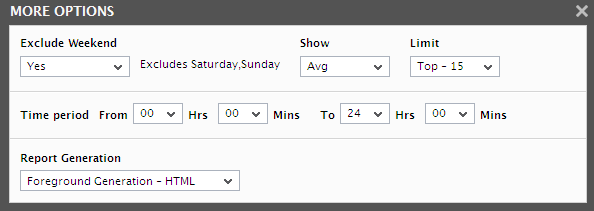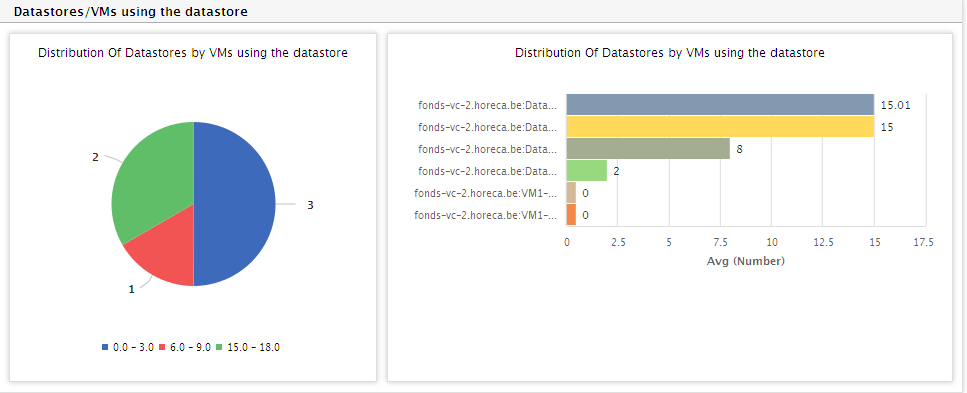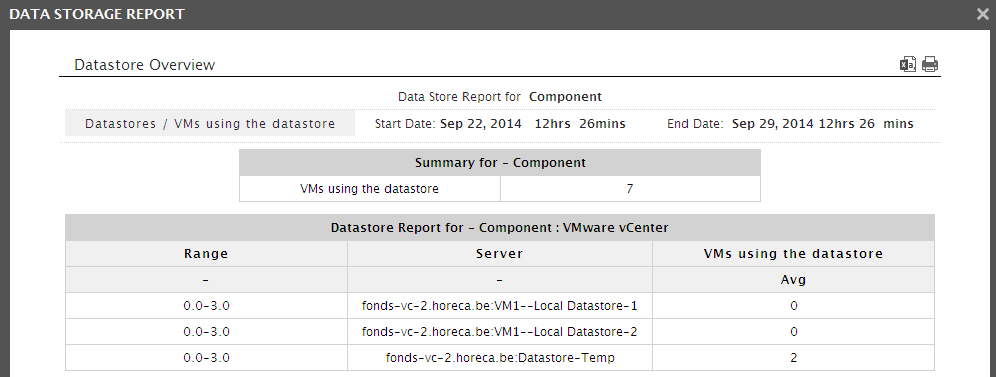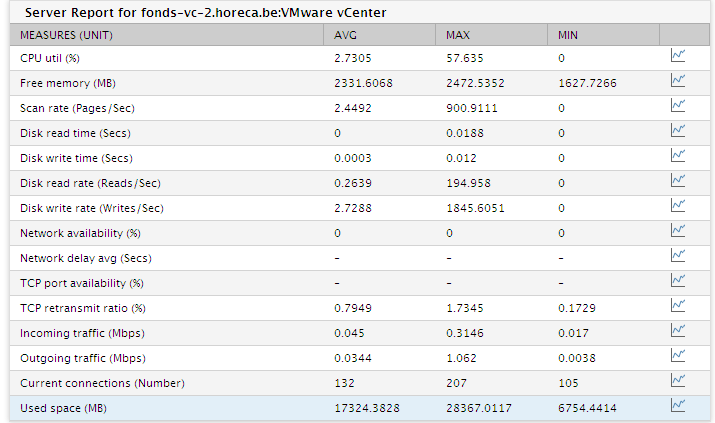Datastore Overview Report
Using this report, the following can be ascertained:
- Are any datastores running out of space? If so, which ones are they?
- Which VMs will be impacted by a space crunch in the datastore?
To generate this report, do the following:
-
Select the Datastore Overview option by following the menu sequence: REPORTS BY FUNCTION -> Domain-specific Reports -> Virtual Applications / Desktops -> Virtualization -> Datastores.

- When Figure 1 appears, first, indicate the Report Type. For a graphical representation of datastore performance, select the Graph option; for tabulated performance results, select the Data option. By default, the Graph option is chosen.
- Next, select the component type for which the report should be generated from the Component Type list box. To view the report for all the component types, select the All Component Types option from the Component Type list box. The All Component Types option will be available if Data option is chosen from the Report Type.
-
Using this report, you can engage in a time-based performance analysis of those datastores that are used by specific ESX servers, the datastores that are managed by one/more vCenter servers, or those datastores that are associated with all the ESX servers/vCenter servers within a particular zone/segment/service. Indicate your choice by picking the one of the following options from the Analyze by list.
- Component:If the Component option is chosen from the Analyze by list, then all components of the chosen Component Type will be listed in the Component list box. From this list box, select the components for which the report is to be generated. If the Component list consists of too many components, then viewing all the components and selecting the ones you need for report generation could require endless scrolling. To avoid this, you can click the
 button next to the Component list. The COMPONENTS pop up window will then appear using which you can view almost all the components in a single interface and select the ones for which the report is to be generated.
button next to the Component list. The COMPONENTS pop up window will then appear using which you can view almost all the components in a single interface and select the ones for which the report is to be generated. - Zone: If the Zone option is chosen from the Analyze by list, then you would be required to select the Zone for which the report is to be generated. In addition, you will also have to indicate whether the report needs to include even those datastores that are associated with the ESX servers/vCenter servers that are included in the sub-zones of the chosen zone. If this is the case, you will have to set the Include sub-zones flag to Yes.
- Service: Select this option if the components for which a report is to be generated are involved in the delivery of a business service. Then, select a Service.
- Segment: Choose this option if the virtual hosts to be evaluated are part of a segment. Then, pick a Segment for analysis.
- Component:If the Component option is chosen from the Analyze by list, then all components of the chosen Component Type will be listed in the Component list box. From this list box, select the components for which the report is to be generated. If the Component list consists of too many components, then viewing all the components and selecting the ones you need for report generation could require endless scrolling. To avoid this, you can click the
-
The speed with which a report is generated depends primarily on the report Timeline. While a Timeline that varies between a couple of days to a week enables the eG Enterprise system to quickly retrieve the required data, timelines that span multiple weeks/months could slow-down the data retrieval and report generation process to a considerable extent, owing to the volume of data involved. In order to ensure quick and easy access to reports, eG Enterprise provides you the option of enabling data retrieval from the Trend information in the database, instead of the Detailed test information that is used by default for report generation. The Detailed test information based comprises of multiple measurement records for a test - one or more each for every test execution. Whereas, the Trend information includes only hourly, daily, and monthly summary computations for a test performed on a continuous basis. For instance, during a period of 1 hour, a test that runs every 5 minutes inserts atleast 12 records into the Detailed test information base. On the other hand, the Trend information base would consist of only 1 record for the same 1 hour period. Fewer the number of records, query execution becomes much quicker, and data retrieval faster. To use the trend data for report generation, you will have to select the Trend option from the Show Data field in Figure 1. By default, the Detailed option is selected in Figure 1 indicating that the report data is retrieved from the detailed test information in the database. If need be, you can also ensure that all reports always use the Detailed test tables alone by hiding the Show Data field from the reporter interface. To achieve this, do the following:
- Login to the eG administrative interface as 'admin'.
- Select the Manager option from the Settings tile that appears when the
 button against the Admin tab is clicked.
button against the Admin tab is clicked. -
From the GENERAL SETTINGS page that then appears, if you set the Compute average/sum of metrics while trending flag to No, then the Show Data field will not appear in the reporter interface; this denies users access to the Trend option, and thus ensures that reports are always generated using the Detailed tables.
Note:
- A Trend report will not include the data for the current day since trend data is only computed at the end of the day.
- If the Trend option is chosen, the time period of the report should be greater than 1 day.
-
The usage of Detailed test tables for generating reports, especially those that span weeks, increases the stress on the eG database, thus resulting in undue delays in report generation. In order to ensure that the database is not choked by such voluminous data requests, you can configure eG Enterprise to automatically "force" the use of the Trend option if the Timeline of a report exceeds a pre-configured duration. To specify this time boundary, do the following:
- Edit the eg_report.ini file in the <EG_INSTALL_DIR>\manager\config directory.
- In the [MISC] section of the file, you will find a DetailedTime parameter.
- Specify the duration (in days) beyond which Detailed reports cannot be generated, against the DetailedTime parameter, and save the eg_report.ini file.
- For instance, to make sure that Detailed reports are disallowed for a Timeline of over 2 weeks, set the DetailedTime parameter to 14 and save the file.
- Say, subsequently, you attempt to generate a Detailed report for a FixedTimeline of 3 weeks (which is greater than the 14-day limit set in our example). The instant you select the 3 weeks option from the Fixed list box, the Detailed option gets automatically disabled, and the Trend option gets enabled. Similarly, if you specify an AnyTimeline that runs over 14 days, then, upon clicking the Run Report button to generate the report, a message box appears (see Figure 8) informing you that only the Trend option is permitted.
- To proceed with the Trend report generation, click the ok button in the message box. To terminate Trend report generation, click the Cancel button.
- Next, pick the Measure for which the Graph report is to be generated.
-
Then, specify the Timeline for the graph. You can either provide a fixed time line such as 1 hour, 2 days, etc., or select the Any option from the list to provide a From and To date/time for report generation.
Note:
For every user registered with the eG Enterprise system, the administrator can indicate the maximum timeline for which that user can generate a report. Once the maximum timeline is set for a user, then, whenever that user logs into eG Reporter and attempts to generate a report, the Timeline list box in the report page will display options according to the maximum timeline setting of that user. For instance, if a user can generate a report for a maximum period of 3 days only, then 3 days will be the highest option displayed in the Timeline list - i.e., 3 days will be the last option in the fixed Timeline list. Similarly, if the user chooses the Any option from the Timeline list and proceeds to provide a start date and end date for report generation using the From and To specifications, eG Enterprise will first check if the user's Timeline specification conforms to his/her maximum timeline setting. If not, report generation will fail. For instance, for a user who is allowed to generate reports spanning over a maximum period of 3 days only, the difference between the From and To dates should never be over 3 days. If it is, then, upon clicking the Run Report button a message box will appear, prompting the user to change the From and To specification.
-
In addition to the settings discussed above, this report comes with a set of default specifications. These settings are hidden by default. If you do not want to disturb these default settings, then you can proceed to generate the report by clicking the Run Report button soon after you pick a Component. However, if you want to view and then alter these settings (if required), click on the
 button. The default settings will then appear in the MORE OPTIONS drop down window (see Figure 2). The steps below discuss each of these settings and how they can be customized.
button. The default settings will then appear in the MORE OPTIONS drop down window (see Figure 2). The steps below discuss each of these settings and how they can be customized.
Figure 2 : The default settings for generating the Datastore Overview report
-
If the timeline specified for the report needs to exclude the data collected during the Weekends, then set Exclude weekends to Yes. If not, select No.
Note:
By default, the weekend constitutes Saturday and Sunday. To override this default setting, do the following:
- Edit the eg_report.ini file in the <EG_INSTALL_DIR>\manager\config directory.
- In the [virtual_datastore] section of the file, the exclude_weekendparameter is set to Saturday,Sunday by default. You can modify this by setting the exclude_weekend parameter to a comma-separated list of other days of the week - say Friday,Saturday.
- Save the file after making the required changes.
- By default, the Graph report computes the Avg value of the chosen Measure, and graphically represents the top-n datastores with a high Avg value. Accordingly, the Avg option is chosen by default from the Show list, and a top-n option is chosen by default from the Limit list. To arrange datastores based on the Current values reported for the chosen measure, pick Current as the option from the Show list.
- Next, indicate the report Timeperiod.
-
In large environments, reports generated using months of data can take a long time to complete. Administrators now have the option of generating reports on-line or in the background. When a report is scheduled for background generation, administrators can proceed with their other monitoring, diagnosis, and reporting tasks, while the eG manager is processing the report. This saves the administrator valuable time. To schedule background processing of a report, you can either select the Background Save - PDF option or the Background Save - CSV option from the Report Generation list. In this case, a Report Name text box will appear, where you would have to provide the name with which the report is to be saved in the background. To process reports in the foreground, select the Foreground Generation - HTML option from this list.
Note:
- The Report Generation list will appear only if the EnableBackgroundReport flag in the [BACKGROUND_PROCESS] section of the eg_report.ini file (in the [EG_INSTALL_DIR]\manager\config directory) is set to Yes.
- The default selection in the Report Generation list will change according to the Timeline specified for the report. If the Timeline set is greater than or equal to the number of days specified against the MinDurationForReport parameter in the [BACKGROUND_PROCESS] section of the eg_report.ini file, then the default selection in the Report Generation list will be Background Save - PDF. On the other hand, if the Timeline set for the report is lesser than the value of the MinDurationForReport parameter, then the default selection in the Report Generation list will be Foreground. This is because, the MinDurationForReport setting governs when reports are to be processed in the background. By default, this parameter is set to 2 weeks - this indicates that by default, reports with a timeline of 2 weeks and above will be processed in the background.
- Finally, click the Run Report button.
-
If the Report Type is Graph and the Report Generation mode is Foreground Generation - html, then, clicking on the Run Report button will reveal Figure 3.

-
Figure 3 comprises of the following:
-
A distribution pie chart that depicts the number of datastores associated with the chosen component-type that are in different distribution ranges. The distribution ranges are obtained by applying the first of the configured functions on the chosen Measure. For instance, assume that Physical disk space usage is the chosen Measure. Say that you have configured to display the Avg and Max of this measure in a Data report. Typically, both these configured values will appear only in the Data report. In the case of a Graph report however, the first of the two functions - i.e., Avg of Physical disk space usage - alone is calculated for every datastore mapped to the chosen component-type. The resulting pie chart enables administrators to deduce, at a glance, the number of datastores where the chosen performance metric has fared well and/or badly. Clicking on a particular slice in the pie chart lists the datastores that fall within the value range represented by that slice (see Figure 4). Against every datastore, the actual values for each of the configured functions (both Avg and Max, in our example) will be displayed. A vCenter-level Summary of the chosen Measure will also be available.

Figure 4 : The physical servers that fall within the usage range clicked on
- Adjacent to the pie chart, you will find a bar chart that indicates the datastores that have topped/failed in a selected performance realm (i.e., the Measure) during the specified Timeline. For example, for the Physical disk space usage measure, this bar chart reveals the datastores that are using the maximum disk space. Unlike the pie chart, the bar chart plots the Avg values of the chosen measure over a period of time, or the Current values of the measure, based on the option chosen from the Show list; the number of datastores displayed in the bar chart also depends upon the top-n or last-n option chosen from the Limit list.
-
-
If the Report Type is Data, then the resulting report will include a table listing all the datastores that were used during the specified Timeline, the number of VMs using each datastore, followed by a wide range of pre-configured and user-configured metrics revealing how effectively each datastore was utilized during the given period. If multiple functions (e.g., Avg, Current, Percent, etc.) have been configured to be applied on a measure, then the report will include a column for every configured function. With the help of this data, you can accurately identify datastores that were down during the stated period, datastores that ran / were running out of space, and the vCenters/ESX servers/VMs that were affected by such anomalies. You can zoom into the performance of a particular component by clicking on the corresponding link in the report - this will invoke a Server Report of that component, which reveals the overall health of the component. In addition, the Datastorage Report embeds a Percent change column, which indicates whether the overall datastore usage was optimal or erratic during the designated period. Sudden and significant spikes in datastore usage could cause the Percent change to increase.

Figure 5 : The Data report for Data Storage

Figure 6 : Clicking on a 'Server' in the Data Storage Report
-
On the other hand, if the Background Save - PDF option is chosen from the Report Generation list, then clicking on the Run Report button will not generate the report and display it in this page for your benefit. Instead, a message indicating that the report is being processed in the background will appear. This will be accompanied by a link that will lead you to the page that lists all the reports that are being processed in the background, and their current status. If background report generation fails for a report, you can regenerate that report using this page, or can even delete that report if need be. On the other hand, if background processing successfully completes for your report, then, you can view a PDF of the report by clicking on the
 icon in that page.
icon in that page. A default set of measures are pre-configured for the Overview report in the [VIRTUAL_DATASTORE] section of the eg_report.ini file (in the <EG_INSTALL_DIR>\manager\config directory); these default measures are Server, Datastore, Datastore availability, Total capacity, Used space, Free space, Percent usage, Percent Change. You can, if you so desire, add more default measures to the [VIRTUAL_DATASTORE] section in the format:
Default:<InternalTest>:<InternalMeasure>#<DisplayName>=<Comma-separated list of functions>.



